Creating engaging YouTube content often hinges on clear, crisp audio. Whether you’re recording vlogs, interviews, or any creative content, the right microphone can elevate your production value significantly. iPhones are known for their quality video, but the built-in microphone doesn’t always do justice to your audio needs. That’s where external microphones come in, providing superior sound capture to complement your visual storytelling. In this listicle, we’ll explore the best iPhone microphones tailored for YouTubers, ensuring your audience hears every word as clearly as they see the images. Read on to discover the key to unlocking professional-level audio for your YouTube channel.
When searching for the best iPhone microphone for YouTube, there are several key criteria you should consider to ensure your videos have crisp, clear audio that enhances your content:
- Compatibility: The microphone must be compatible with your iPhone model and iOS version, ensuring seamless integration.
- Sound Quality: High-quality audio capture is essential. Look for microphones with noise cancellation and the ability to record in various environments.
- Directionality: Microphones come in different pickup patterns. A cardioid microphone is typically preferred for vlogging, as it focuses on the sound in front of the camera and reduces background noise.
- Portability: For YouTubers on the go, a compact and lightweight microphone that’s easy to carry is ideal.
- Ease of Use: The microphone should be plug-and-play if possible, requiring minimal setup time and technical knowledge.
- Durability: The build quality should withstand regular use, especially if you’re frequently filming in different locations.
- Battery Life: If the microphone requires its own power source, it should have a battery life that can last through your recording sessions.
- Additional Features: Features like a headphone jack for real-time monitoring or the inclusion of a windscreen for outdoor recording can be beneficial.
Using these criteria, we’ll review a selection of the best iPhone microphones suitable for YouTube creators.
Please note that the prices may vary depending on the retailer and current promotions. The prices mentioned should be considered as approximate and are included for comparison purposes only.
| Microphone | Price* (Approx) | Key Specifications | Directional Pattern | Connects to iPhone via |
| Shure MV88 Portable iOS Microphone | $150 | – Digital Stereo Condenser Mic – 24-bit/48 kHz recording quality – 5 DSP Preset Modes | Adjustable Patterns | Lightning Connector |
| Rode VideoMic Me-L Directional Microphone | $80 | – Pressure Gradient Electret Condenser – Frequency Range: 20Hz – 20kHz – No Battery Required | Cardioid | Lightning |
| Apogee MiC Plus Studio Quality USB Microphone | $260 | – Studio Quality – PureDIGITAL Connection – Up to 24-bit/96kHz recording quality – No Configuration Required | Cardioid | USB to |
| Comica CVM-VS08 Professional Cardioid Condenser Microphone | $50 | – Super Cardioid Pattern – Frequency Range: 80Hz – 16000kHz – Plug and Play | Cardioid | 3.5mm TRS |
| Boya BY-M1 3.5mm Electret Condenser Microphone | $20 | – Omnidirectional Lavalier Mic – Frequency Range: 65Hz – 18kHz – Battery Powered with LR44 Battery | Omnidirect. | 3.5mm |
Remember, some iPhone models may not have a 3.5mm headphone jack, and in such cases, an additional dongle (a 3.5mm to Lightning adapter) may be needed to use microphones with 3.5mm connectors. This comparison does not account for other important factors such as durability, size and weight, additional features, or overall sound quality, which are also crucial in making a purchasing decision. Always check the latest product specifications and reviews to ensure the chosen microphone meets your specific needs.
Shure MV88 Portable iOS Microphone
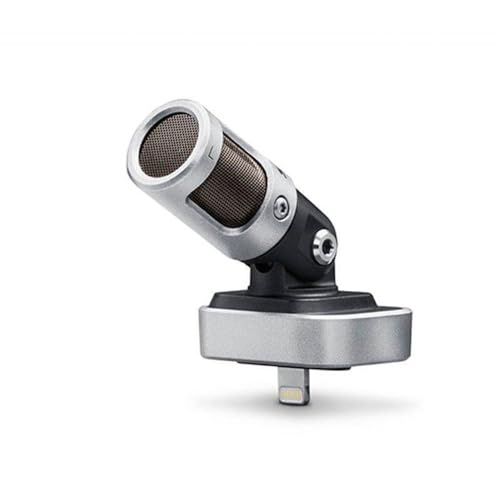
Overview:
The Shure MV88 Portable iOS Microphone is a stellar piece of recording equipment designed specifically for use with Apple devices. As someone who’s used this microphone for several projects, I can attest to its remarkable versatility and ease of use.
Out of the box, the MV88’s build quality impresses, feeling sturdy enough to handle the rigors of on-the-go recording. The setup is a breeze; simply plug it into your iPhone’s Lightning port, and you’re ready to capture high-quality audio. The ShurePlus MOTIV app greatly enhances the user experience, providing intuitive controls and customizable settings for different recording environments.
The sound quality is nothing short of phenomenal for such a small device. I’ve captured everything from street interviews to acoustic guitar sessions, and the MV88 consistently delivers clear, detailed sound with minimal background noise.
Specs:
- Transducer Type: Cardioid (10 mm)/Bidirectional Condenser Cartridge
- Frequency Response: 20 Hz to 20 kHz
- Adjustable Gain: 0 to +36 dB
- Five preset modes including Speech, Singing, Flat, Acoustic Instrument, and Loud
- Built-in headphone output for real-time monitoring
- Includes a zippered carrying case and a windscreen
Pros:
- Exceptional audio quality for its size
- Highly portable and durable, making it excellent for field recordings
- The adjustable mic elements (90° hinge) enhance recording flexibility
- Lightning connector provides a secure, direct connection to your iPhone
Cons:
- The necessity of a Lightning port means it’s not compatible with USB-C iPad models without an adapter
- It can be pricey for the casual user who doesn’t require professional-grade audio
- No analog connection option limits usability with non-iOS devices
Price:
The Shure MV88 comes in at a premium price, usually around $149. While it may seem steep for a mobile microphone, the investment is justified by its superior audio quality, robust construction, and excellent digital features for serious content creators.
In my opinion, the Shure MV88 is an exceptional piece of equipment for any YouTuber or mobile journalist looking for professional sound quality without the bulk of traditional recording gear. It may be pricier than others on the market, but the quality and reliability of audio recordings you get from the MV88 are second to none.
Rode VideoMic Me-L Directional Microphone
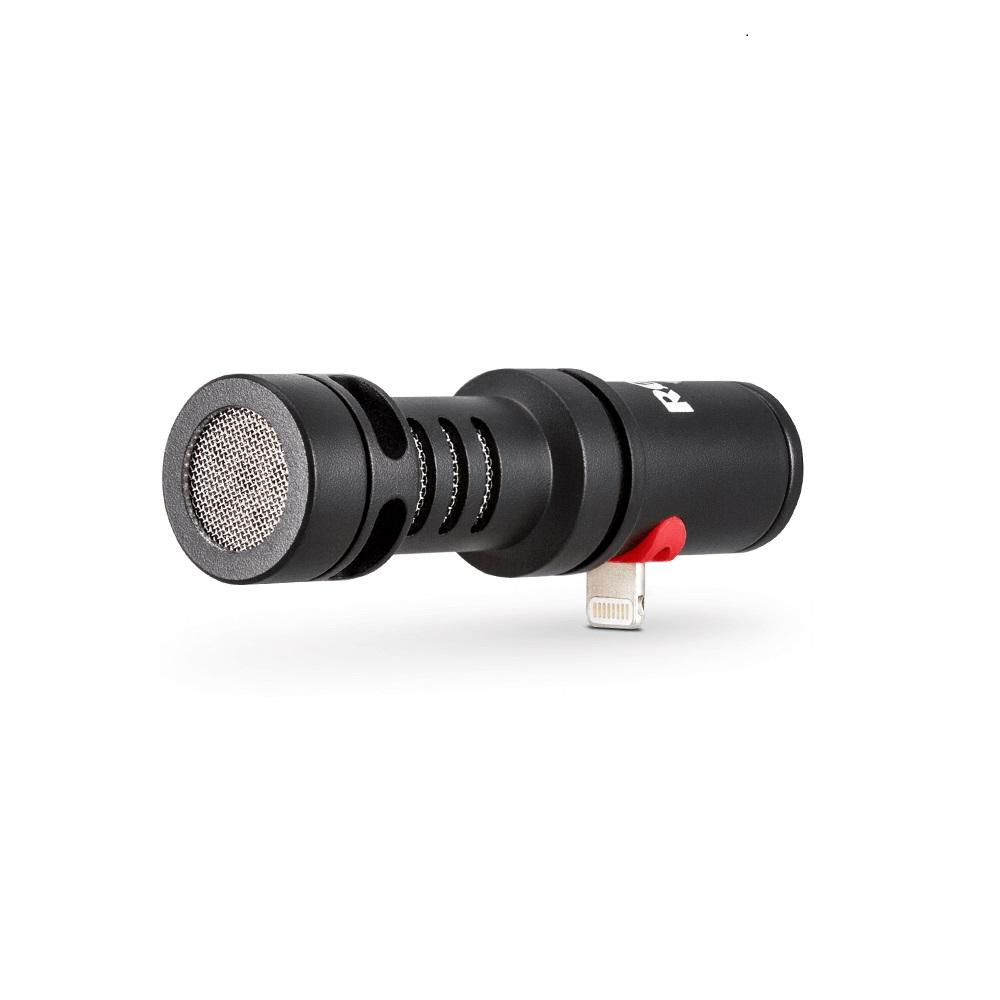
Overview:
The Rode VideoMic Me-L is a compact and highly directional microphone designed for iOS devices. For YouTubers looking for sharp audio that focuses on the subject and rejects surrounding noises, this mic is a real gem. Designed to plug directly into your iPhone or iPad via the Lightning connector, the VideoMic Me-L is ideal for vloggers, musicians, and any content creator who demands quality sound on the go.
In my personal experience, this microphone has proven to be a game-changer for mobile recordings. Its directional nature means it excels at capturing sound where you point it, significantly reducing ambient noise and focusing on the intended subject. This is especially handy for outdoor shoots or busy environments where control over audio is crucial. The microphone’s build quality feels robust, providing a reassuring sense of durability that’s vital for on-location work.
Specs:
- Acoustic Principle: Pressure gradient electret condenser
- Polar Pattern: Cardioid
- Frequency Range: 20Hz – 20kHz
- Signal to Noise Ratio: 74.5 dB
- Maximum SPL: 115 dB SPL
- Connector: Lightning connector
- Dimensions: 73.5 x 20.2 x 25.7 mm
- Weight: 28 grams
- Accessories: Windshield, mic clip
Pros:
- Excellent sound quality with a focus on clarity and directionality.
- Plug and play functionality makes it extremely easy to use with no need for additional software or batteries.
- Included windshield is a boon for reducing wind noise during outdoor recordings.
- Lightweight and ultra-portable, making it ideal for mobile setups and minimalistic rigs.
Cons:
- The Lightning connection restricts you to iOS devices, so if you’re considering switching to Android or need versatility, this could be a limiting factor.
- Due to its directionality, it requires careful positioning to ensure the best audio pickup, which might not be ideal for more spontaneous recording situations.
Price:
The Rode VideoMic Me-L is typically priced around $79. This places it at a mid-range price point where it offers substantial value for the quality and features it provides. In the realm of mobile audio recording for YouTube, it strikes a pleasing balance between cost and performance.
In sum, the Rode VideoMic Me-L is a commendable choice for any iPhone-toting YouTuber who’s serious about their audio game. Whether you’re a roaming vlogger or an aspiring filmmaker, this microphone provides the audio quality you need without unnecessary complexity or bulk.
Apogee MiC Plus Studio Quality USB Microphone
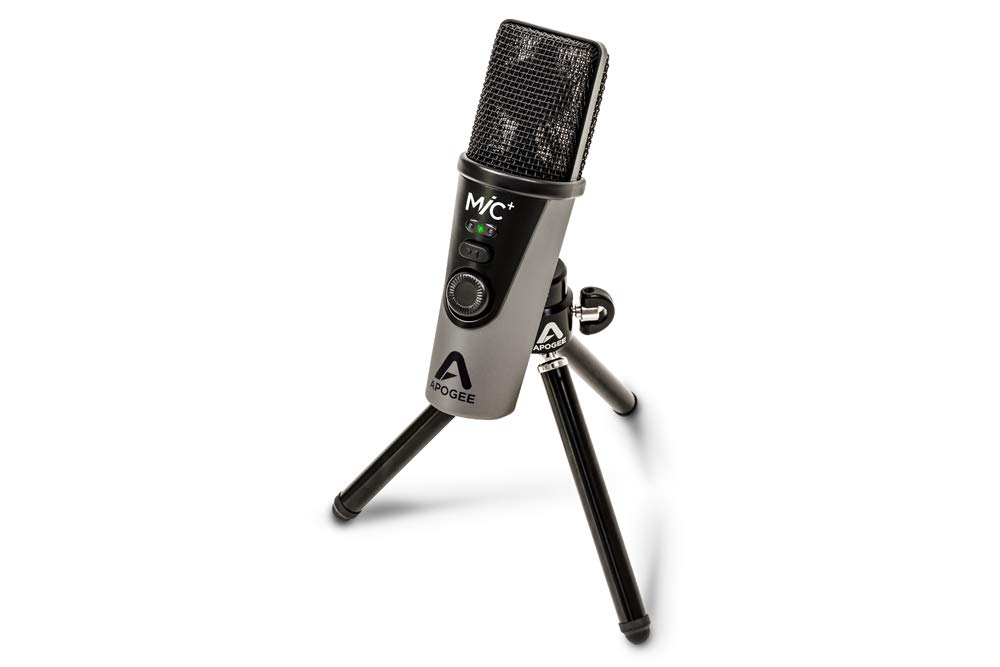
Overview:
The Apogee MiC Plus is an exceptional piece of equipment, especially tailored for content creators and audio enthusiasts looking to capture studio-grade recordings on their iPhone. The mix of portability and quality that this microphone offers sets it apart from many others in the market. My experience with the Apogee MiC Plus has been nothing short of impressive. Straight out of the box, you’ll notice its solid build and sleek design.
Once plugged in, it’s incredibly simple to use as it interfaces seamlessly with your iOS device. The sound quality is what really takes the cake – it captures clean, detailed, and natural audio. Its cardioid pickup pattern does an excellent job at focusing on the sound that’s directly in front of it, which means your voiceovers or musical recordings are free from unwanted background noise. Overall, the Apogee MiC Plus is a powerful tool that can elevate any YouTube creator’s audio to professional heights.
Specs:
- Microphone Type: Condenser
- Polar Pattern: Cardioid
- Frequency Response: 20Hz – 20kHz
- Max SPL: 130dB (1% THD at 1kHz)
- Connector Type: USB, Lightning
- Additional Features: Blend function for zero-latency recording
Pros:
- Excellent audio quality that rivals professional studio microphones
- No noticeable latency, thanks to the onboard Blend feature
- Easy to set up and use with iPhone, no need for extra adapters
- Portable and durable, making it ideal for field recordings or travel vlogging
Cons:
- On the pricier side compared to other iPhone microphones
- Lacks multiple pickup pattern options which could limit versatility
- The necessity of carrying a separate device (as opposed to mini microphones that attach directly to the iPhone)
Price:
At the time of writing this review, the Apogee MiC Plus is on the higher end of the pricing spectrum, typically retailing around $250. Although this may seem steep, the investment is justified by the professional audio quality and robustness of the product.
It’s important to mention that prices can fluctuate and it’s always wise to search for deals or promotions that may be available. Keep in mind that in the world of audio equipment, quality often comes at a premium, and the Apogee MiC Plus is a testament to that adage. If audio quality is a high priority for your YouTube channel, this microphone could be a game-changer for you.
Comica CVM-VS08 Professional Cardioid Condenser Microphone
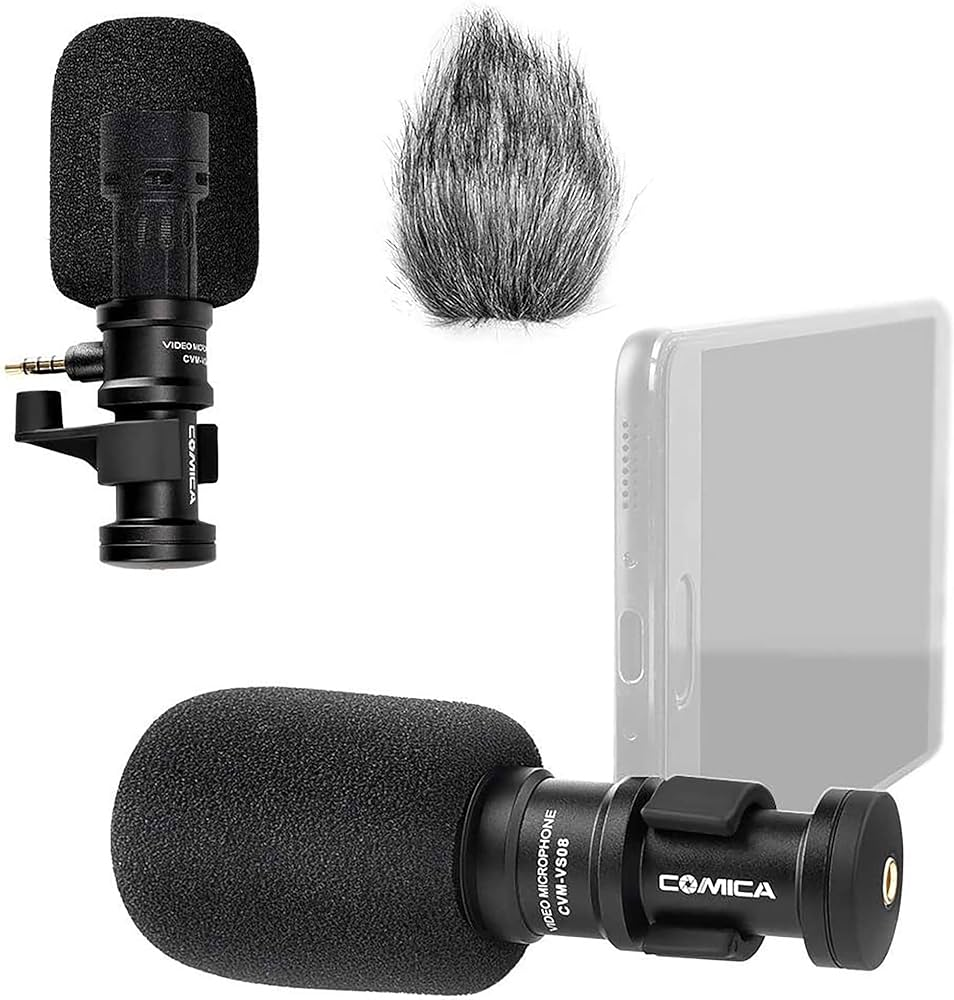
Overview:
The Comica CVM-VS08 is an impressive piece of audio equipment designed with the mobile content creator in mind. What strikes me right off the bat is its targeted appeal for YouTubers who leverage their iPhones to shoot their video content. It has a sleek, no-frills appearance that suggests utility and efficiency.
The performance of the CVM-VS08 is what stands out. It delivers crisp, clear audio that significantly enhances the production value of any YouTube video. As a cardioid microphone, it excels at picking up sound from the front, which means less unwanted background noise in your recording. I appreciated the thoughtfulness in design with the inclusion of a wind muff for outdoor shooting conditions – a common setting for vloggers.
Its plug-and-play functionality is a godsend for creators who prefer to avoid complicated setups. The microphone snugly attaches to the iPhone, eliminating any need for cumbersome wires or additional power sources. The build quality gave me confidence that it could withstand the rigors of being frequently taken on the go.
Specs:
- Polar Pattern: Cardioid
- Frequency Response: 80Hz-16kHz
- Sensitivity: -34dB±3dB
- Signal to Noise Ratio: >58 dB
- Weight: Just over an ounce (34.2g)
Pros:
- Excellent portability; it’s small and lightweight.
- Solid construction feels durable for regular use.
- Cardioid pattern is great for focused recording, minimizing background noise.
- The included windscreen is effective for outdoor recording.
- Plug-and-play with no battery required offers incredible ease of use.
Cons:
- The audio quality, while good, may not compete with some high-end microphones, especially in complicated audio environments.
- Limited adjustability in terms of recording angles due to its design.
- It may not be the best pick for users who need multi-directional recording capabilities.
Price:
For the quality and functionality it provides, the Comica CVM-VS08 sits at a reasonably affordable price range. While prices can vary depending on the retailer, you can typically expect to find it around $50. Given its specific use-case and straightforward functionality, it’s positioned as a mid-market contender that offers solid value for money, especially for burgeoning YouTubers who need a reliable, portable mic that won’t break the bank.
Boya BY-M1 3.5mm Electret Condenser Microphone
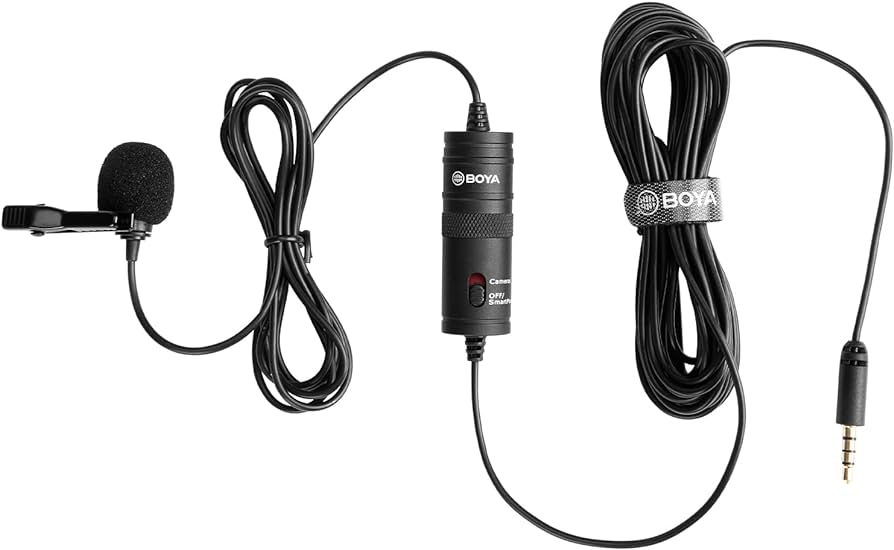
Brief Intro
The Boya BY-M1 is a versatile lavalier microphone that is designed with content creators in mind. Its lavalier design makes it perfect for hands-free recording, allowing you to clip it onto your clothing with ease. It’s particularly popular among YouTubers who require a reliable, budget-friendly mic that enhances audio quality without the need for a professional studio setup.
Overview
Upon testing the Boya BY-M1, I immediately noticed the improvement it brought to my audio recordings. The microphone is unobtrusive, allowing for a more natural presentation on camera, which is crucial for creating an engaging viewer experience. The inclusion of a lengthy cable is a double-edged sword; it allows you freedom of movement during recordings but can be cumbersome to manage if you’re stationary. Sound quality is where the Boya BY-M1 stands out in its price range. It delivers a clear, crisp sound with a focus on vocal frequencies, making it an excellent choice for vloggers, interviewers, and anyone needing to record speech.
Specs
The omnidirectional pickup pattern is adept at capturing sound from all directions, which ensures consistent audio levels, even if you move slightly during recording. One feature that I particularly appreciate is the mic’s compatibility with both smartphones and cameras, thanks to the included 3.5mm jack and a 1/4″ adapter. It also comes equipped with a small power pack that requires a LR44 battery to function, which can add a little bulk, but the added volume and clarity it provides are well worth it.
Pros:
- Affordable, offering good value for its price point.
- Long cable provides extensive mobility for varied recording setups.
- Decent sound quality for a budget microphone enhances vocal clarity.
- Easy to use with a simple clip-on system for fast setup.
Cons:
- Cable management can be a hassle due to its length.
- Requires a battery, which means you need to monitor its power level to avoid interruptions.
- Build quality feels a bit cheap, though this is expected at a lower price bracket.
Price
The Boya BY-M1 is a steal, usually found at around $15-$20. This makes it an incredibly cost-effective solution for improving audio quality, especially when compared to other microphones in the market that can cost significantly more. It’s a solid investment for those starting out on YouTube or for creators who need an affordable backup microphone.
Personal Opinion
I find the Boya BY-M1 to be an excellent entry-level microphone. It offers a substantial upgrade from built-in smartphone or camera mics without breaking the bank. While it may not boast the premium feel or advanced features of more expensive options, it performs reliably well where it matters most – sound quality. For newcomers to YouTube or those on a tight budget, it’s a practical choice that doesn’t disappoint.
Conclusion
In this roundup, we’ve explored a variety of iPhone microphones catered to enhance your YouTube content with superior audio quality. Whether your budget is modest or you’re ready to invest in top-tier equipment, there’s a mic to fit your needs and elevate your video production. Remember, crisp and clear sound can make a world of difference in audience engagement and the perceived professionalism of your content. Choose wisely to ensure your voice is heard just as you intend it to be.
Looking for greater flexibility and crystal clear audio when filming YouTube content on an iPhone? A wireless lavalier microphone is the ideal solution, delivering professional-quality sound and allowing you complete freedom of movement.
Best Seller
Sale
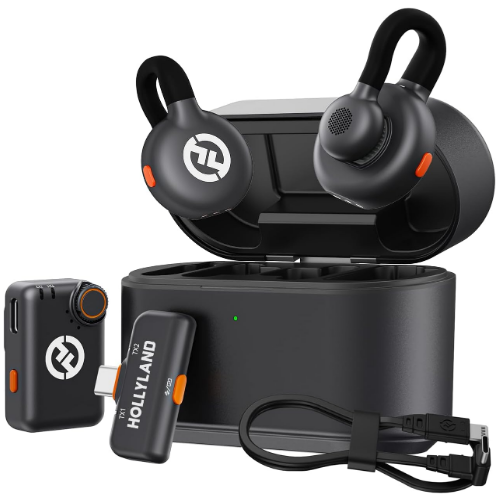
Hollyland LARK M2S – Wireless Clip-on Microphone
- 7g Lightweight, Titanium Clip, Discreet Design
- Clear sound with 24-bit/48kHz, 70dB SNR, 116dB SPL
- Noise Cancellation & 300m Long-Range Stability
- Works with Camera/iPhone/Android/Laptop
- Perfect for Content Creators, Online-Teaching, Streaming
$139
$159
FAQs
Q1: Do I really need an external microphone for my iPhone if I’m just starting on YouTube?
A: Yes, even if you’re just starting, an external microphone can significantly improve the quality of your audio, which is crucial for retaining viewers and growing your channel.
Q2: Can I use these microphones for other types of recording besides YouTube?
A: Absolutely! These microphones are versatile and can be used for podcasting, music recording, or any situation where you need to record high-quality audio on your iPhone.
Q3: Are there compatible microphones for both iPhone and other devices?
A: Many microphones come with multiple connectors or adapters that make them compatible with a range of devices including iPhones, other smartphones, cameras, and computers.
































.png)



